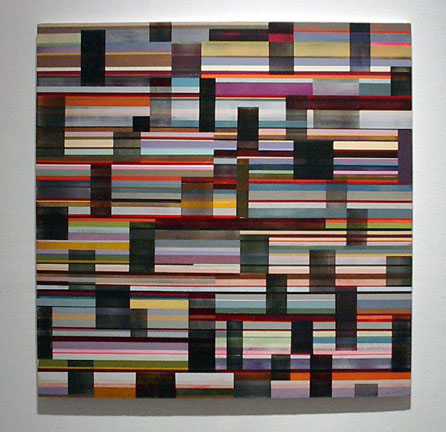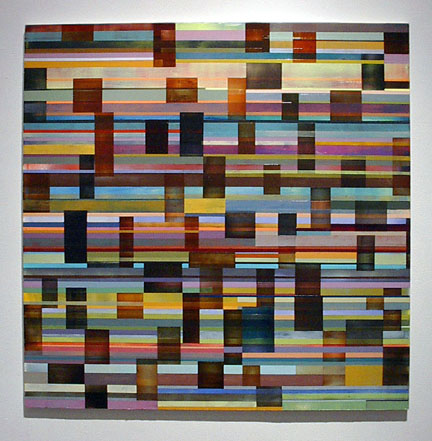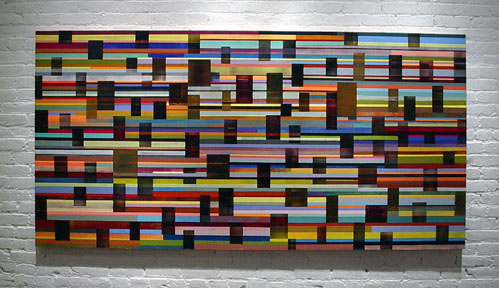Linda Day
Solo exhibition, 2003
2003
36x36", Acrylic on panel

2003
36x36", Acrylic on panel

2003
96x46", Acrylic on panel

|
Linda Day |
|
|
"Pulse #3"
2003 36x36", Acrylic on panel |
 |
|
"Pulse #4"
2003 36x36", Acrylic on panel |
 |
|
"Pulse #5"
2003 96x46", Acrylic on panel |
 |
Back to Archive
Press Release
May 1, 2003
Exhibitions:
Pulse, new paintings by Linda Day
(a)Kin, curated by Linda Day, Abstract Paintings and Drawings by: Lynne Berman, Susan Cheal, Nancy Evans, Tom Monteith, Hector Romero, Katie Stubblefield, Marie Thibeault
Exhibition Dates: May 24 - June 28, 2003
Regular Hours: Thursday - Saturday, 12:00 noon - 6:00 PM
Reception: Saturday, May 24, 7:00 - 9:00 PM
(a)Kin, curated by Linda Day
All of the artists included in (a)KIN were trained as painters, each maintaining a commitment to its practice. All are deeply concerned with issues of contemporary painting and, as some would see it, the problem of abstraction. In the face of a so-called “crisis” in painting, several have sought to revitalize their practices by periodically engaging in others. Some never vacillate from the practice of painting, celebrating its limitations, comfortable with the weight of its history. And finally, as the title of the exhibition suggests, all of the artists are friends of mine and are essential to my creative and intellectual community - as well, of course, to a much larger community of artists by virtue of their talent, intellect, commitment, and integrity.
Tom Monteith and Marie Thibeault are artists that remain faithful to the inspiration that the natural landscape provides for them. Both insist on the primary significance of a physical relationship to nature in their studio practice. In Marie Thibeault’s and Tom Monteith’s paintings rhythmic horizontal marks contribute to the compression of light and form and, to differing degrees, the collapse of space. Tom maintains a closer allegiance to the experienced physical landscape, particularly in his sometimes panoramic horizontal paintings. Marie’s work attempts to convey a sense of “ecstatic fusion” between the viewer and, as Marie writes, “the continually oscillating field of energy that ultimately reflects the structure and imprint of the body within the construct of a landscape space.” Both artists address the sublime in its most romantic sense.
Both Hector Romero and Katie Stubblefield have for long periods of time focused on drawing. Hector’s exquisite drawings are filled with images and text, yet when he comes to painting his work is entirely abstract - an intimate and intuitive response to color and mark. Katie has focused on on-sight drawing, mapping architectural spaces and, like an archeologist, uncovering the history of those spaces. Her paintings are a by-product of that investigation.
Lynne Berman, known for her installation and performance work, has all the while maintained a painting practice. These new paintings depict an architectonic space in which the “here” and “there” becomes ambiguous, creating a kind of dislocation and feelings of vertigo.
Nancy Evans’ new “poured” paintings are a natural outgrowth of her dyed fabric installations of the past and are evidence of Nancy’s search for a spontaneous, more natural method of shaping compositions and making marks. In these deceptively simple paintings shapes are defined within poured forms, creating an eccentric relationship between shifting figures and an unstable ground.
Having recently completed a body of sculpture, Susan Cheal finds herself once again making paintings, a predictable cycle in her creative practice. These new paintings consist of marks and shapes gleaned from earlier more painterly works, from selected corporate productivity diagrams, from minimalist paintings – all symbols of her experience of the world and her personal history. As Susan writes, “There is a distance and dissociation in the making of a painting that has crept up upon me - a tendency to eliminate the gesture and engage less directly with the painting itself.... I am endeavoring to invent a vocabulary that has to do with the superficial, the surface, and an alternative way of presenting metaphor and metonymy.”
As painters we all work in relative isolation. We are alone in our studios - and when we collaborate, it is with phantoms from the past that are not always the most gracious of guests. I am often amused by how often the word “fun” is used as a criteria for art: “It looks like fun, like the artist was having fun when she or he made the work.” I suppose the term suggests our need for pleasure both in the experience of making and viewing art. It seems so simple, having “fun” – and yet this enterprise isn’t Disneyland, no matter how much that particular landmark and, more importantly, it’s mythos, defines the Los Angeles state of mind. My own suspicion is that the longer one engages in art-making, the more elusive the “fun.” And so, in the end, we look to our friends, artists who, by virtue of their triumphs in the struggle to maintain a vital creative practice, not only win our admiration, but inspire and challenge us. (Linda Day, May 1, 2003)
PULSE
New Abstract Paintings by Linda Day
Mine is not a linear art making practice in which one series of paintings builds directly on another. I was giving a talk about my work recently and I described my process as being “two steps forward, one step back - like a diagram of ellipses stretching out over the last twenty years.” My work has fluctuated between a more formal abstraction and one that is more clearly identified with image and metaphor, depending on the differing degrees of my intellectual or emotional involvement with the work. This, I think, suggests that there are times in which I remain more distanced from the image and other times when the image presents autobiographical opportunities.
This new work is evidence of my effort to make paintings that reflect the steady stream of visual and auditory in-put, of technological filler that permeates our culture. In this space a fusion is created between the human and technological and the beat of the human heart is tracked with the steady pulse of the apparatus. Surround sound. Saturated color extends across the screen. I am dreaming of Vistavision, Cinemascope.
But take it down…
Peer into the studio. The radio is on constantly and, if not the radio, voices on the TV murmur at the edge of the room. There is comfort in the constant stream of voices, in the rhythmic pulse at the periphery of my vision.
(Is there anything more disquieting than silence, than an absolute void?)
The steady hum. The flutter and flux.
In this fullness there is no room for an uninvited intruder, an unwelcome thought.
My breath, my pulse echoes that of the room.